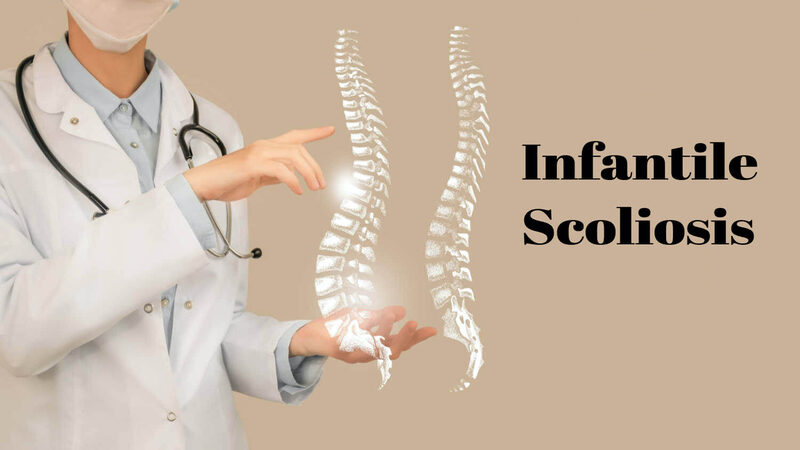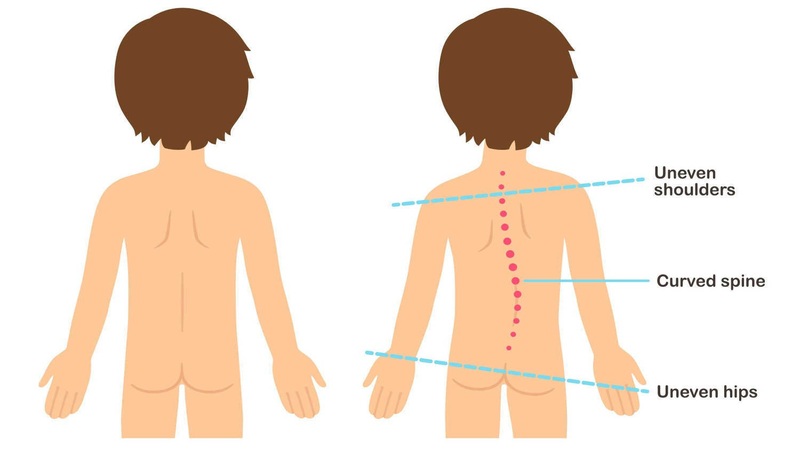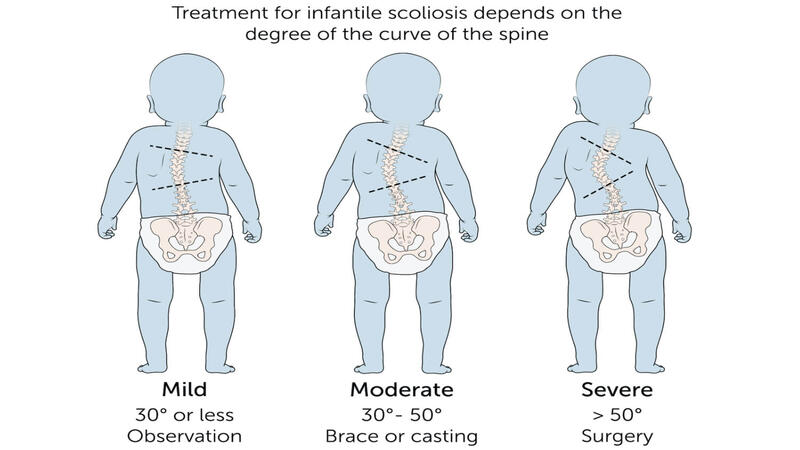
Infantile Scoliosis is a condition where the child’s spine has an abnormal curve. It majorly affects children below 3 years. The condition is also known as Idiopathic Scoliosis, meaning the cause is unknown but there are some assumptions about why it happens. The good news is that the illness is entirely treatable. The Scoliosis that affects children who are three to eight years is called juvenile scoliosis.
Scoliosis can first show up soon after birth. This can happen due to hereditary factors or abnormal conditions in the womb. The baby sleeping for long time on its back during the initial months is also believed to cause this condition. Here are a few more things to know about this condition, diagnosis and treatment options.
What is Infantile Scoliosis?
Scoliosis is where the spine has an abnormal curve. Usually, the spine has a straight line until the middle of the back. In the case of Scoliosis, the straight line is curved in the form of “S” or “C” until the middle point of the back. Most often, Scoliosis is confused with poor posture. Scoliosis is an abnormality in the spine and should not be confused with poor posture.
When Children between 3 to 8 years get affected by Scoliosis, it is known as Juvenile Scoliosis. It is important to note that both infantile and Juvenile Scoliosis are early onsets and Idiopathic.
Signs of Infantile Scoliosis

The degree of illness due to scoliosis may range from mild to Severe. Moderate and severe Scoliosis may appear as the difference in posture. The following are some signs to look out for in Infantile Scoliosis.
- Shoulders tilted unevenly, looking uneven, and one shoulder blade protruding higher than the other.
- Uneven Waistline
- One leg might look longer than the other.
- Overall body position may be leaning to one side.
- Ribs are placed unevenly over one side.
- The difference in hip height or position.
- The Head might not be in the center position of the shoulders.
- When your baby stands straight, one arm might hand beside the body.
- When your little one bends forward, there may be differences in the height between the sides of the back.
You need to know that these conditions do not cause any pain to the babies. So, you must be careful about looking out for the signs and symptoms of Scoliosis.
Top Three Main Causes of Infantile Scoliosis
Infantile Scoliosis is believed to be Idiopathic Scoliosis. It means that the reason for the illness is unknown. However, there are three different theories that can explain the root causes for this condition
1. Intra-Uterine Modelling Theory
According to this theory, a fetus spine may be affected during the growth phase due to an abnormal position of the fetus inside the uterus or due to the pressure exerted by the uterine walls on the fetus.
2. Post-Delivery Theory
This theory postulates that a baby sleeping for longer hours continuously on their backs in their crib may sometimes experience deformities leading to infantile scoliosis.
3. Genetic Inheritance
Genes are thought to be a major contributing factor for infantile scoliosis. Though the gene is yet to be identified, this condition is seen to run in families, making the inheritance theory more plausible.
Diagnosis of Infantile Scoliosis

Early Detection can help your baby get out of Infantile Scoliosis at the earliest. You can take the help of your doctor to look out for the symptoms and diagnose Infantile Scoliosis. The following are some of how Scoliosis can be diagnosed.
Imaging tests help the doctors look closer over the spine and check the bones to measure the degree of the curve. X-rays are the most preferred and best methods to identify infantile Scoliosis and precisely show the curves’ angles in a two-dimensional picture. If there is some problem in the X-ray or the X-ray shows something abnormal, the doctors might suggest the following tests.
1. EOS Imaging
This test is done when the baby is in a standing or upright position. The test uses ultra-low dose radiation and creates three-dimensional models with the help of two planar images.
2. Magnetic Resonance Imaging (MRI)
MRI uses large magnets, radio frequencies, and a computer to create a detailed picture of all the organs inside the body. It does not use radiation for image capturing. So, your baby is not exposed to radiation in MRI.
3. Computed Tomography (CT) Scan
A CT scan uses the combination of X-rays with computer technology to create cross-sectional pictures of all the organs in the body. This is much useful in detecting ribcage issues.
4. DEXA Scan
A radioisotope bone scan or DEXA Scan helps identify the health of the spinal bone.
Different Treatment Options Available For Infantile Scoliosis

The Treatment of Scoliosis depends on the severity of the illness. If your baby has mild infantile Scoliosis-ranging curves less than 25 degrees, they can do good without going into surgery. Regular monitoring and other treatments can help them be good in the long run. For some infants, it goes away.
Babies with a progressive or severe illness need to get into treatment immediately to reduce the degree of effect of Scoliosis.
The following are the various treatments available for infants who have Scoliosis.
1. Bracing and Therapeutic Exercise For Infantile Scoliosis
If your baby is suffering from Moderate Scoliosis, i.e., with scoliosis ranging between 25 to 40 degrees, the following are the treatments to be considered.
a) Back Bracing
It helps in giving adequate support to the curve and holding them in a partially corrected posture. It also prevents deformity from progressing.
b) Serial Body Casting
Under this treatment, your baby would be put under anesthesia, while the spine will be manipulated, and a body cast will be placed around the torso. The process is repeated until the child grows, usually for three years. Casting is preferred for children from 6 months to 6 years. It is proven effective in straightening the curved spine, especially when the treatment begins early, before 18 months.
c) Scoliosis Exercises
Babies who have mild scoliosis may benefit from scoliosis exercises. It helps to correct the posture and improve balance and positioning.
2. Surgical Interventions
If your Baby is affected severely by Infantile Scoliosis, the doctors might prefer to intervene with surgery. Different kinds of surgery are available based on the severity of the illness.
a) Growing Rods
In this surgery, the curve in the spinal cord is spanned with two rods attached to the spine below the curve. It helps in guiding the spinal cord and drives them to grow straight.
As your child grows, the rods need to be expanded. Your baby might need to be admitted and get the rods expanded every six months.
b) Vertebral Body Tethering
Under this procedure, the tethering cords are placed along one side of the spine to stop the growth and enable the growth of the spine to straighten to the other side.
c) Vertical Expandable Prosthetic Titanium Ribs (VEPTR)
As your child grows, if the spinal cord affects the ribs, your child may also be diagnosed with Thoracic Insufficiency Syndrome. In such a case, the doctors might recommend VEPTR. It relaxes the spine and allows the ribs, lungs, and spine to grow and expand.
d) Spinal Fusion
If your baby has undergone VEPTR and is now grown up, they need to undergo Spinal Fusion. This permanently stabilizes the spine. The abnormally aligned spine is reshaped and fused with the help of metals implanted to correct the curve.
When Should You See a Doctor?
If you notice abnormal growth in your Baby’s spine, do not hesitate to check with your doctor immediately. Early detection is extremely important to ensure timely intervention so that your baby with have a normal childhood and a normal life
FAQ’s
1. Can Infantile Scoliosis Correct Itself?
If your baby has a mild severity of Scoliosis, not all, but in some instances, scoliosis might correct itself in the long run. Nevertheless, a consultation with the doctor might be necessary.
2. Is Infantile Scoliosis Hereditary From Mom or Dad?
There are no proven researchers to conclude that scoliosis is hereditary. It is still a debatable question.
3. What is the Right Age For Infantile Scoliosis Surgery?
Scoliosis surgery may begin from 6 months until 6 years.
4. Is Scoliosis in Babies a Lifetime Condition?
If detected early and cured, it can be saved from being a lifetime condition.
Read Also: Neonatal Abstinence Syndrome – Symptoms, Causes and Treatment

